Linkedin has a total of 955 patents globally, out of which 695 have been granted. Of these 955 patents, more than 3% patents are active. United States of America is where Linkedin has filed the maximum number of patents, followed by India and Europe (EPO). Parallelly, United States of America seems to be the main focused R&D centre and also is the origin country of Linkedin.
Linkedin was founded in the year 2002. The Company operates a social networking web site. The Company allows members to post a profile of their professional expertise and accomplishments on web site.
Do read about some of the most popular patents of Linkedin which have been covered by us in this article and also you can find Linkedin patents information, the worldwide patent filing activity and its patent filing trend over the years, and many other stats over Linkedin patent portfolio.
How many patents does Linkedin have?
Linkedin has a total of 955 patents globally. These patents belong to 894 unique patent families. Out of 955 patents, 30 patents are active.
How Many Patents did Linkedin File Every Year?
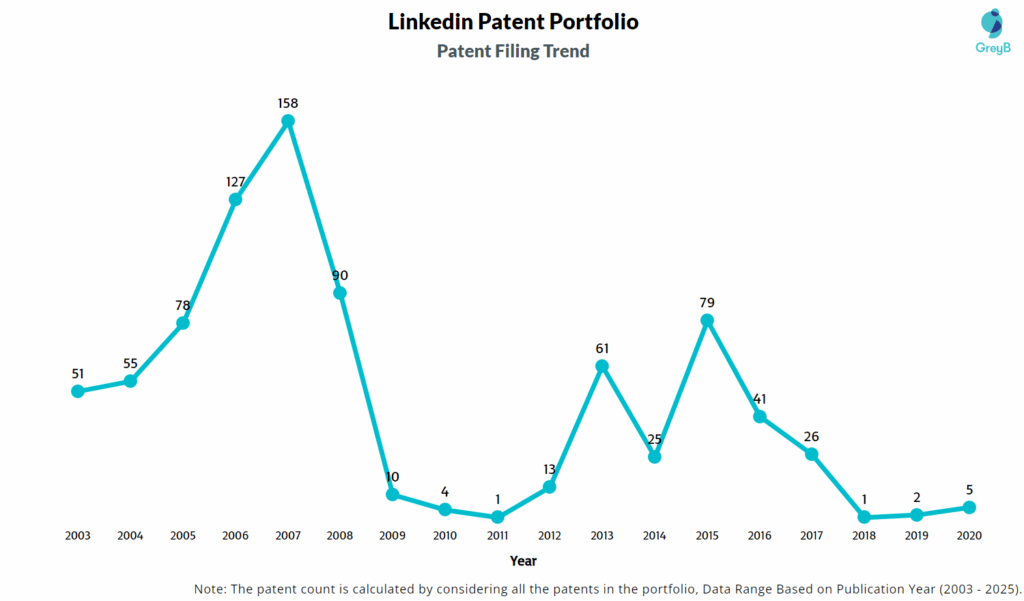
Are you wondering why there is a drop in patent filing for the last two years? It is because a patent application can take up to 18 months to get published. Certainly, it doesn’t suggest a decrease in the patent filing.
| Year of Patents Filing or Grant | Linkedin Applications Filed | Linkedin Patents Granted |
| 2024 | – | 2 |
| 2020 | 5 | 1 |
| 2019 | 2 | 2 |
| 2018 | 1 | 1 |
| 2017 | 26 | 2 |
| 2016 | 41 | 1 |
| 2015 | 79 | – |
| 2014 | 25 | 1 |
| 2013 | 61 | – |
| 2012 | 13 | 2 |
How many Linkedin patents are Alive/Dead?
Worldwide Patents
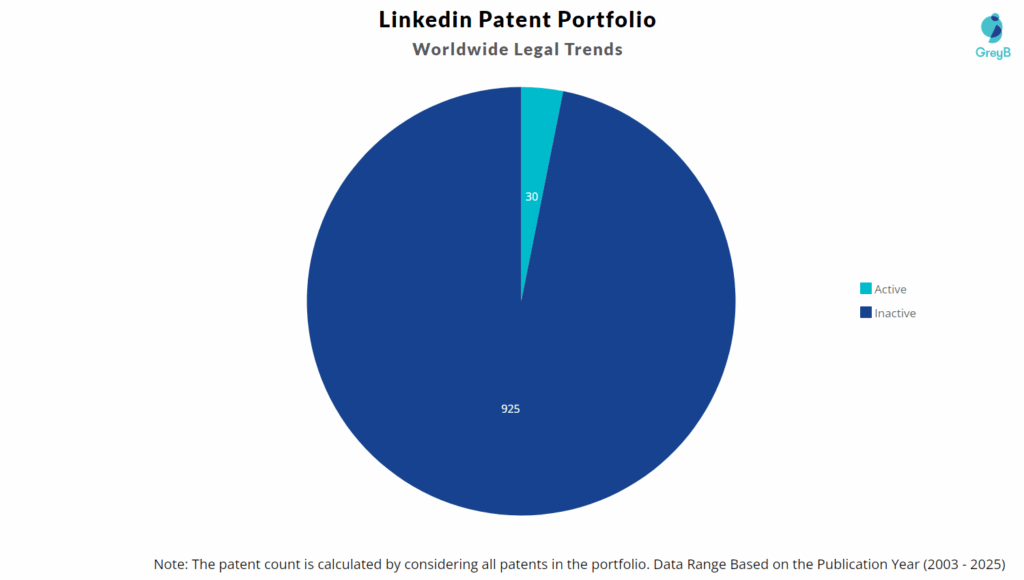
How Many Patents did Linkedin File in Different Countries?
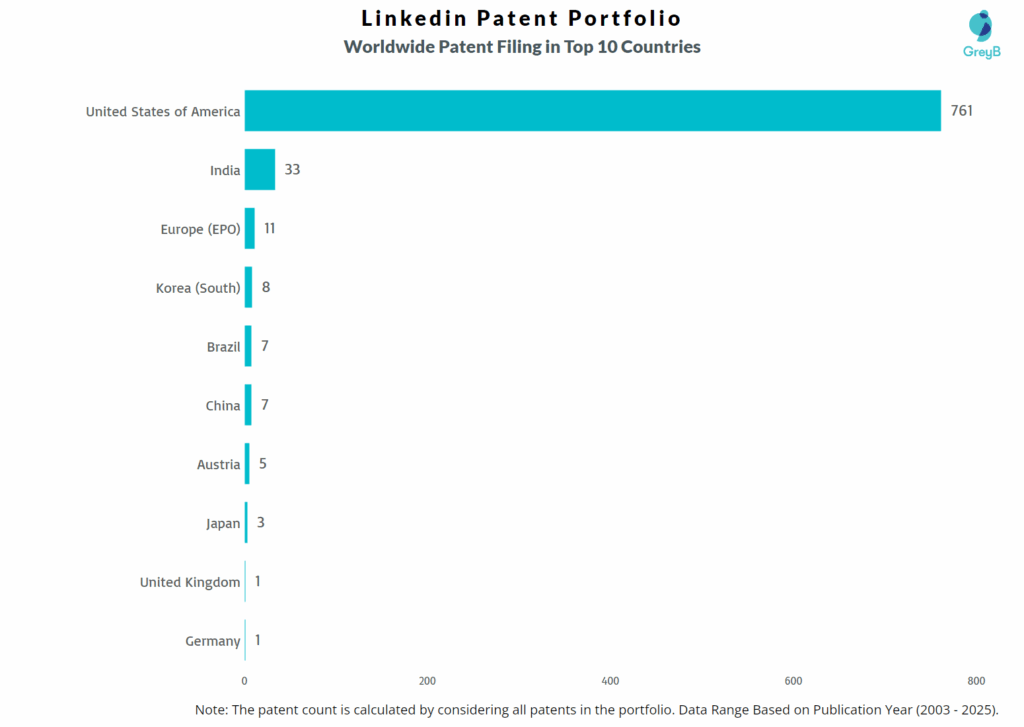
Countries in which Linkedin Filed Patents
| Country | Patents |
| United States of America | 761 |
| India | 33 |
| Europe (EPO) | 11 |
| Korea (South) | 8 |
| Brazil | 7 |
| China | 7 |
| Austria | 5 |
| Japan | 3 |
| United Kingdom | 1 |
| Germany | 1 |
Where are Research Centres of Linkedin Patents Located?
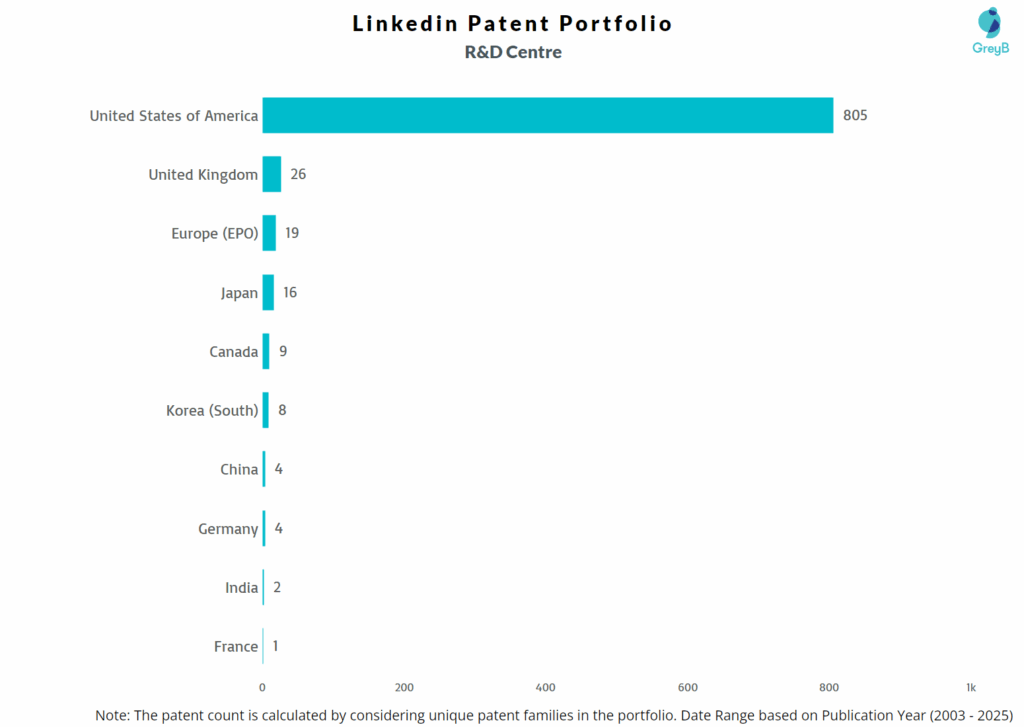
10 Best Linkedin Patents
US20140149519A1 is the most popular patent in the Linkedin portfolio. It has received 374 citations so far from companies like Snapchat, Wistron and IBM.
Below is the list of 10 most cited patents of Linkedin:
| Publication Number | Citation Count |
| US20140149519A1 | 374 |
| US7159150B2 | 311 |
| US7818165B2 | 300 |
| US7792328B2 | 271 |
| US7809587B2 | 256 |
| US7747774B2 | 223 |
| US7855101B2 | 222 |
| US7003551B2 | 216 |
| US7814142B2 | 210 |
| US20130254305A1 | 188 |
How many inventions of other companies were rejected due to Linkedin patents?
The statistics below share strategic R&D insights. It tells the companies that were trying to protect inventions similar to Linkedin invention. They couldn’t because Linkedin had protected those before them.
Examiners at the USPTO referred 513 Linkedin patents in 3581 rejections (35 USC § 102 or 35 USC § 103 types).
The top citing companies in the Linkedin patent portfolio are IBM, Microsoft and Samsung.
List of the Companies whose Patents were rejected citing Linkedin –
| Company | Number of Patent Applications that faced Rejection Citing Linkedin Patents | Number of Rejections (102 & 103) |
| IBM | 252 | 509 |
| Microsoft | 161 | 365 |
| Samsung | 39 | 84 |
| Meta | 35 | 63 |
| Sap Se | 34 | 67 |
| Oracle | 32 | 67 |
| 29 | 56 | |
| Fujitsu | 26 | 56 |
| Apple | 25 | 47 |
| Amazon | 23 | 51 |
Count of 102 and 103 Type Rejections based on Linkedin Patents
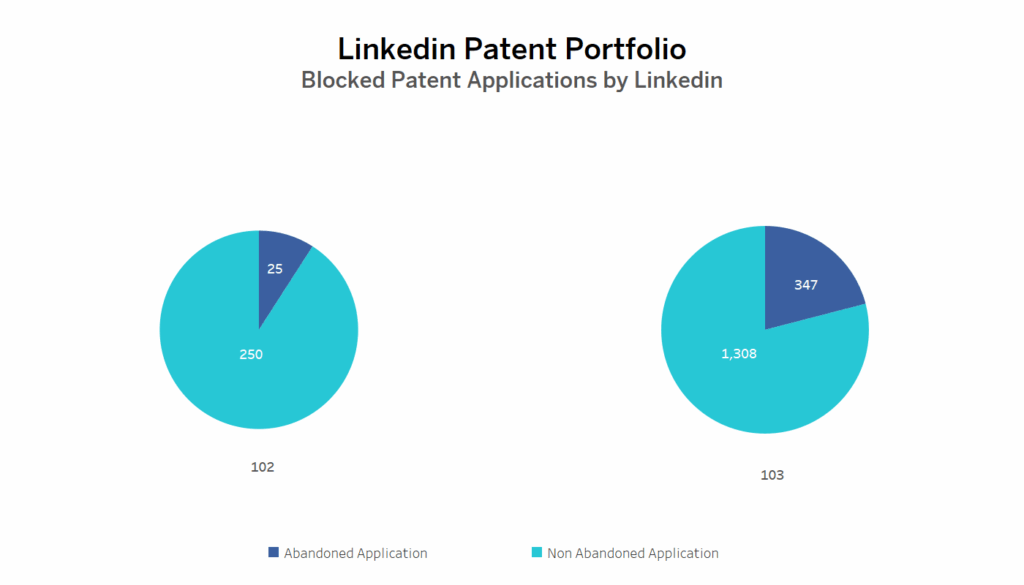
Top Linkedin Patents used in Rejecting Most Patent Applications
| Patent Number | Count of Rejected Applications |
| US7003551B2 | 25 |
| US7822860B2 | 21 |
| US7792328B2 | 20 |
| US20150006286A1 | 19 |
| US7844917B2 | 15 |
| US7113988B2 | 15 |
| US20150006295A1 | 15 |
| US7809587B2 | 14 |
| US7817584B2 | 14 |
| US7792784B2 | 14 |
| US7761429B2 | 14 |
| US7844354B2 | 13 |
| US7814142B2 | 13 |
| US20130254305A1 | 13 |
| US7870398B2 | 12 |
In a variety of ways, LinkedIn has changed the traditional recruiting and job-search sector. Initially, LinkedIn just took low-tech operations and placed them online (e.g., printing and distributing resumes, small-scale headhunting, etc.), but this quickly expanded to include more than just recruiting and early versions of the platform. LinkedIn immediately identified the value of network effects in its company after creating one of the earliest online professional networks.
More users on LinkedIn, for example, make the network a more valuable database for recruiting organizations, increasing the likelihood that those companies will locate qualified applicants in a timely manner. As more users join, LinkedIn can mine and filter user data in real-time to help to recruit organizations proactively uncover interesting individuals. Furthermore, the value marketers and advertisers gain from LinkedIn is strongly linked to the number of users on the network as well as the amount of information those users make available (e.g., age, gender, geographic location, work experience, etc.). These network effects have given LinkedIn a competitive moat, allowing it to grow on its own success.
The “economic graph,” as CEO Jeff Weiner describes it, is the next step in LinkedIn’s digital transformation of traditional recruiting and job search. The economic graph would be a computerized representation of every economic opportunity in the globe, as well as full profiles and data on all enterprises, universities, and the world’s 3 billion professional workers. As a step in this direction, LinkedIn purchased Lynda.com, an online education provider.
EXCLUSIVE INSIGHTS COMING SOON!
What are LinkedIn’s key innovation segments?
What Technologies are Covered by LinkedIn?
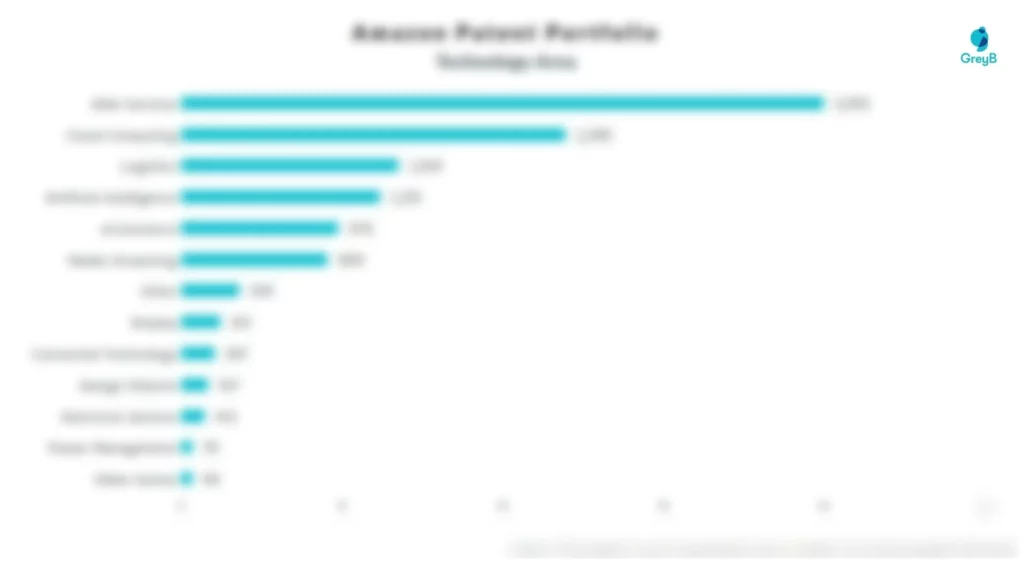
The chart below distributes patents filed by LinkedIn in different countries on the basis of the technology protected in patents. It also represents the markets where LinkedIn thinks it’s important to protect particular technology inventions.
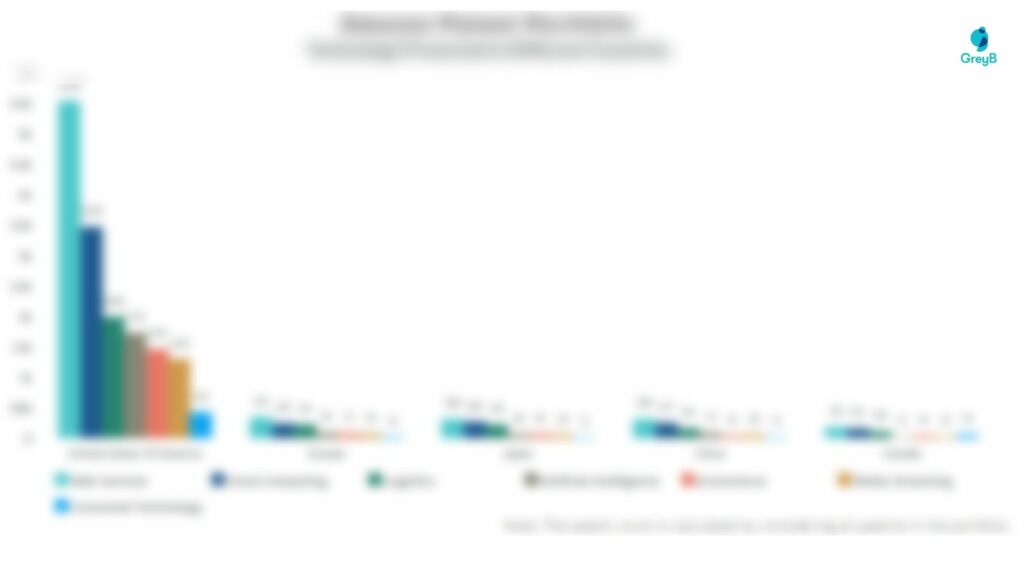
R&D Focus: How LinkedIn search focus changed over the years?

EXCLUSIVE INSIGHTS COMING SOON!

